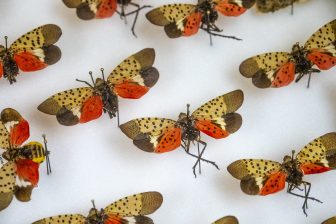
Spotted lanternflies damage a variety of crops and are spreading rapidly across the United States. Image: USDA
By David Strayer
If you’ve driven Michigan’s highways lately, you’ve probably seen the billboards: a big picture of a lanternfly, with the message, “See it. Squish it. Report it.” This is good advice, as far as it goes, but it should go further.
The spotted lanternfly is a serious pest that is poised to cause major economic and ecological damage across the Great Lakes region. It was accidently brought into Pennsylvania about 10 years ago, probably in a shipment of landscaping stone from China that was not properly inspected or disinfected. It is already very common throughout the Mid-Atlantic and is spreading rapidly across the United States, including Illinois, Indiana, New York, and Ohio. Earlier this month Michigan confirmed that the species had arrived in Wayne County, after detecting it previously in Monroe and Oakland counties.
The lanternfly is a problem because it becomes so abundant that it badly damages many plants, including crops such as soybeans, grapes and apples, as well as forest trees. One study estimated that lanternflies may cause hundreds of millions of dollars in damages each year to crops and forests in Pennsylvania alone, and they could be similarly destructive throughout the Great Lakes region.
We will not be able to keep this pest out of our area but we can slow its spread, reducing damages and buying time to develop effective controls. For instance, scientists are trying to find natural enemies of the lanternfly that might be safely imported from its home in Asia, but it will take time to find and screen these enemies.
As the billboards say, you can help slow the spread of lanternflies by squishing them and by reporting them to authorities, who may be able to eradicate new infestations and keep them from spreading. You can also help by checking vehicles, outdoor furniture, recreational equipment and other belongings for lanternfly eggs, and scraping off and disposing of any eggs that you find (double-bagged, into the trash), instead of giving them a ride for hundreds of miles up to your cottage or friend’s place. These inspections are especially important if you’re coming from a heavily infested area like Pennsylvania.

If you find a spotted lanternfly egg mass, like the one shown here on a pallet, double-bag it and throw it in the trash. Image: USDA
But if we really want to solve our problems with destructive invaders like the lanternfly, we need to do more than squish them and report them after they arrive – we need to keep them from arriving in the first place. Dozens of non-native species establish themselves in North America each year, and numbers are rising. Invaders arrive from overseas as hitchhikers on inadequately inspected and inadequately treated cargoes of imported goods, as deliberate imports in the legal pet and horticulture trades and as smuggled contraband.
People sometimes say that biological invasions are an inevitable price we pay for a global economy, but that’s not quite right – they are an inevitable price we pay for a careless global economy. If we are smart about our trade practices, we can greatly reduce biological invasions without imposing crippling costs on the economy.
A good example comes from right here in the Great Lakes, which were being heavily invaded in the 1980s and ‘90s by species riding in untreated ballast water in ships, including the zebra mussel. The states and provinces around the Great Lakes got together and demanded strong controls on releases of ballast water into the lakes. As a result, shipping-related invasions in the Great Lakes dropped almost to zero. This has probably already prevented dozens of new invaders from reaching our waters, and did not require closing down the shipping industry, just shipping smarter.
There are many other ways to prevent biological invasions – better controls on pet and plant imports, better inspections of cargoes and better treatment of wooden packing materials, for example. But the government has been slow to apply those measures, in part because there has been little political pressure from the public whose interests are being damaged by these invasions.
You can help to prevent future invasions by helping to generate that political pressure. If you’re tired of seeing one after another of our forest trees wiped out by invasive pests; our crops threatened by new pests like the spotted-wing drosophila that contributed to this summer’s disastrous cherry harvest; our yards and gardens overrun by aggressive new weeds; and basically having to deal with a new invasive species each summer, then it’s time to write your legislators. Tell them that you want effective federal action to slow the arrival of new invaders. Ask them to fully fund the USDA Animal and Plant Health Inspection Service, the agency that protects us from many of these harmful species and whose budget has been cut so badly that it has had to drop essential programs. Urge them to sponsor legislation that better controls the careless trade practices that bring new invaders into our ecosystems.
So if you’ll allow me to amend those billboards, I’d say: See it. Squish it. Report it. Then write to your members of Congress.
David Strayer has been studying biological invasions for more than 30 years. He is a Distinguished Senior Scientist Emeritus at the Cary Institute of Ecosystem Studies, and lives in Ann Arbor, Michigan.